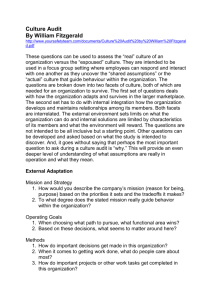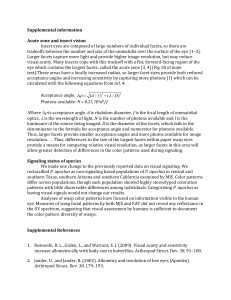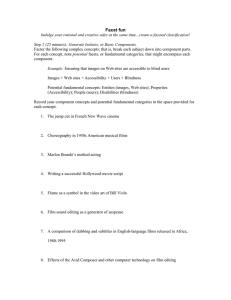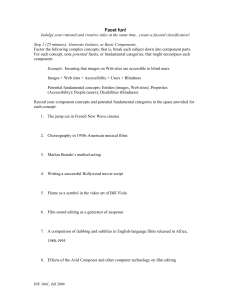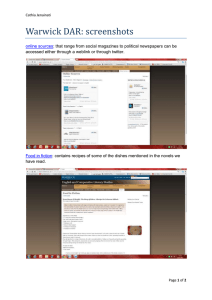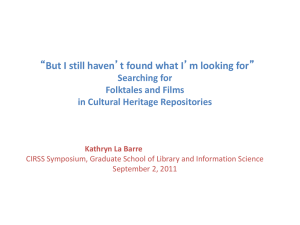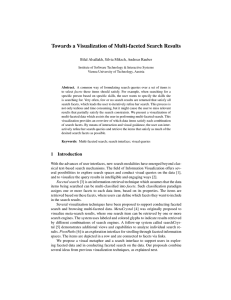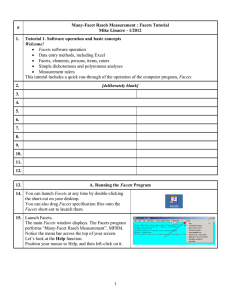Game: factor fun
advertisement
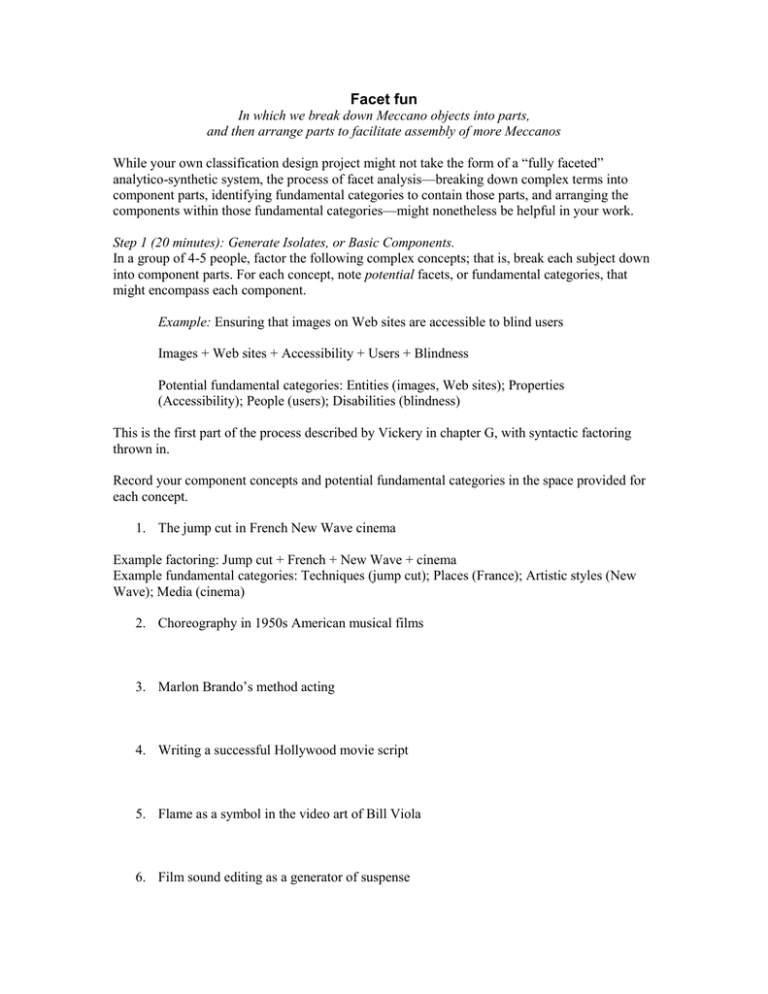
Facet fun In which we break down Meccano objects into parts, and then arrange parts to facilitate assembly of more Meccanos While your own classification design project might not take the form of a “fully faceted” analytico-synthetic system, the process of facet analysis—breaking down complex terms into component parts, identifying fundamental categories to contain those parts, and arranging the components within those fundamental categories—might nonetheless be helpful in your work. Step 1 (20 minutes): Generate Isolates, or Basic Components. In a group of 4-5 people, factor the following complex concepts; that is, break each subject down into component parts. For each concept, note potential facets, or fundamental categories, that might encompass each component. Example: Ensuring that images on Web sites are accessible to blind users Images + Web sites + Accessibility + Users + Blindness Potential fundamental categories: Entities (images, Web sites); Properties (Accessibility); People (users); Disabilities (blindness) This is the first part of the process described by Vickery in chapter G, with syntactic factoring thrown in. Record your component concepts and potential fundamental categories in the space provided for each concept. 1. The jump cut in French New Wave cinema Example factoring: Jump cut + French + New Wave + cinema Example fundamental categories: Techniques (jump cut); Places (France); Artistic styles (New Wave); Media (cinema) 2. Choreography in 1950s American musical films 3. Marlon Brando’s method acting 4. Writing a successful Hollywood movie script 5. Flame as a symbol in the video art of Bill Viola 6. Film sound editing as a generator of suspense 7. A comparison of dubbing and subtitles in English-language films released in Africa, 1980-1995 8. Effects of the Avid Composer and other computer technology on film editing 9. The role of women in Communist society as portrayed in Soviet propaganda films 10. Staging objective event reenactments in documentaries 11. Audience and critical reception of Academy-Award-winning movies 12. Stylistic differences between Japanese and American computer animation 13. Film scores in the spaghetti Western 14. Nonlinear sequence and plot development in contemporary film 15. Studio sets and location shooting: the relative effect on verisimilitude in television dramas Step 2 (25 minutes): Determine Facets to Group the Isolates. Create a set of 5 to 9 facets, or fundamental categories, to contain all the components that you identified in step one. When appropriate, identify subfacets within a primary facet. (For example, in a facet of Schools, you might identify subfacets “by grade level” and “by instructional philosophy” and “by subject-matter emphasis” to characterize, respectively, elementary schools, Montessori schools, and performing-arts schools). Create a structure of facets and subfacets that would enable you to place all your component concepts from step 1. To make this easier, first clarify the classification’s domain and targeted user group (for example, a classification to organize documents about Web site design for people with disabilities, for an audience of Web designers). Begin with your ideas for fundamental categories from each of the 15 items in Step 1 (such as Techniques, Places, Artistic Styles, Media) and see how those work. This is the second part of the process described by Vickery in chapter G. Chapter H talks more about fundamental categories, or facets. Consider the following principles for determining facets as you perform this exercise: • Independence (are the facets mutually exclusive?). • Semantic importance and cohesiveness (do the facets represent the most important fundamental types in the domain?) • Balance (are the facets at similar levels of abstraction?) • Comprehensiveness (do the facets include all important subject components in the domain?) • Hospitality (would it be easy to add more concepts to a facet?) • Relevance (are the facets of interest to the identified user group and purpose)? Create a structure of facets and subfacets that would enable you to place all your component concepts from the 15 items in Step 1 (such as jump cut, France, New Wave, cinema). Record your facet/subfacet structure on the following page. Facet structure Domain of classification: Targeted user group: Step 3 (20 minutes): Engage Another Group’s Approach. In this phase, each group will examine the structure created by another. Our ultimate goal here is to provide, in brief sentences, three potential improvements to the other group’s classification and three elements that were done well. Being able to provide constructive yet critical feedback to your colleagues is a vital skill in professional life. In performing your evaluation, consider the following: Is the structure complete? Can all the component concepts be included? Is the structure cohesive? Can you discern a logic to it, and a sense of balance? Is the structure hospitable? That is, would it be easy to add facets, subfacets, and values? Are the facets relevant to the domain and user group? Are the facets homogeneous and mutually exclusive? (Would it be possible to put a single component concept in multiple places in the facet structure?) Record your feedback on the following page. Evaluation of another group’s facet structure

